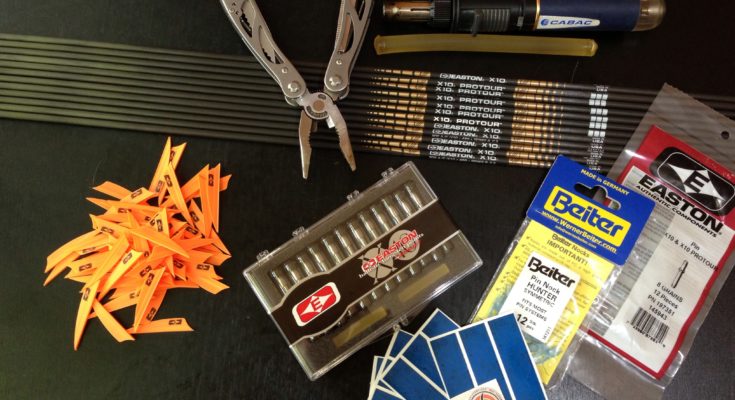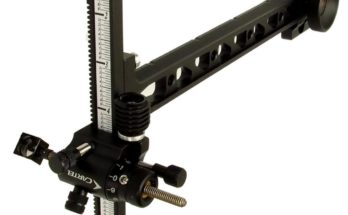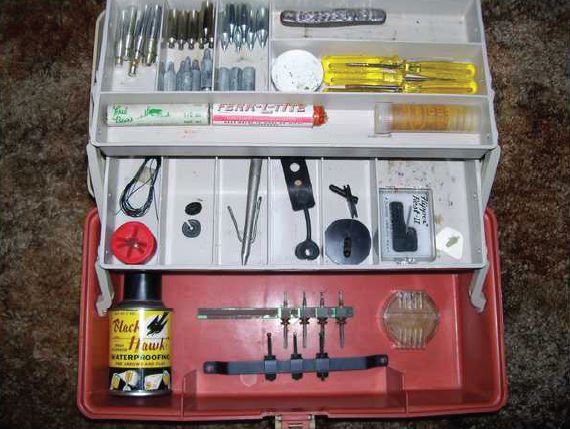Have you thought about what you need in a tournament, or what you might need?
Have you thought about what you’d do if something broke?
When you start out in archery, you’ve got the basic kit: bow, arrows, string, quiver, tab/release aid, fingersling. Everyone is the same. It’s pretty rare that a novice thinks about what they might need to do in the future to take care of their gear, or what might happen if something breaks or goes sour.
When a novice has been shooting for a few months or more, they learn that certain supplies are handy to carry around. Spare arrows is the first thing. Spare nocks and fletches the second, and spare fingertab or release usually the third! Early on in archery, senior clubmembers are usually on hand to help out with trickier problems like reserving, nocking points, D-loops, broken rests or higher-tech changes like draw length.
It’s a good idea to learn to take care of your own equipment, even if on a basic level, and it’s a better idea to have spare supplies on hand so you know you can easily replace stuff. Imagine you’re at a tournament, and your arrow rest breaks! But you have a spare in your bowcase, or your tackle box – easily replaced – and you’re back to shooting in no time.
Having a tackle box isn’t expensive, or even hard work. Most archers gather together bits and pieces over time that they either store in their bowcase, or they have in a box that they carry around, even if that box just stays in their or their parents’ car. Quite often it’s a good way to get your parents involved if they aren’t sure what to do – many dads (and mums) really enjoy taking care of their kid’s gear.
Most tackle boxes I’ve seen are fishing tackle boxes – cheap to get and easy to categorise the stuff inside. Other people have custom tackle boxes that they’ve made themselves, or they’ve bought toolboxes that are hard-wearing for durability – especially if they’re into field archery or bowhunting.
Friends of mine have very comprehensive tackle boxes that contain everything they need to repair their bows or arrows if catastrophe strikes (excepting a broken bow of course!) But yours doesn’t have to be that detailed, or even that expensive.
Below is a list of basic stuff that’s good to have for everyone – in case of breakage – which means you can quickly get back up and shooting if something goes wrong.
- Bow-stringer
- String wax (Either use the wax that dealers sell, or use a piece of candle. It works just as well.)
- Spare string (This should be the same as what you are using. What is also helpful is if you’ve set it up beforehand, making sure the nocking point is correct.)
- Spare fletches (the same colour/s as the ones on your arrows. If you are using two colours, don’t forget to carry spares for both colours. )
- spare nocks (the same as the ones already on your arrows. )
- Super glue (The $2 shop Super glue is great as it is a bit slower to adhere than normal superglue, giving you time to position correctly. Repaired arrows should not be used for 24 hours after repair.)
- a sharp knife
- a pen for your arrows
- spare pencil (and sharpener)
- spare fingertab / release aid / fingersling / armguard (Make sure these are the same as what you are already using. With the finger sling it doesn’t matter so much, but with the fingertab it pays to have used it a bit beforehand just so your fingers are comfortable with it.)
- spare D-loop and peep sight for compounders
- spare arrow rest (Always pays to have a spare in your tackle box. It should be the same one you are using, but in case you break that too, think about having a spare white stick-on – they’re great in a pinch!)
- spare plunger button if you use one
- plasters (just in case!)
- ANZ membership card
Other stuff you might like to include:
- Allen keyes (metric and imperial)
- Hot melt for points and pins
- serving string
- serving tool
- extra sight parts
- butane torch or lighter
- bow square
- nock pliers
- scissors
- fletching jig
- portable bow press
Caro Geelen
(This article first appeared in issue 514, March/April 2013)




